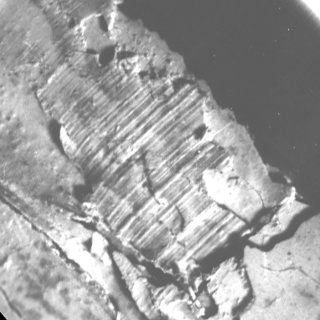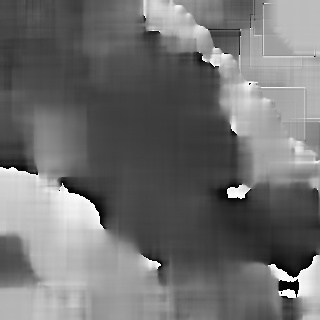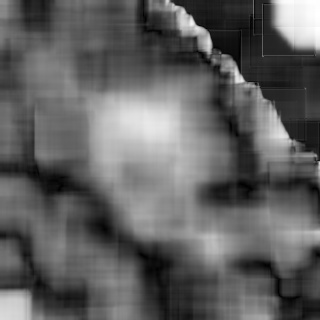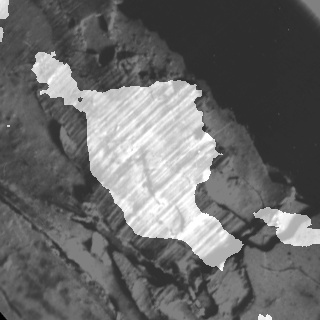Prev Tutorial: Motion Deblur Filter
Next Tutorial: Periodic Noise Removing Filter
| |
| Original author | Karpushin Vladislav |
| Compatibility | OpenCV >= 3.0 |
Goal
In this tutorial you will learn:
- what the gradient structure tensor is
- how to estimate orientation and coherency of an anisotropic image by a gradient structure tensor
- how to segment an anisotropic image with a single local orientation by a gradient structure tensor
Theory
- Note
- The explanation is based on the books [114], [19] and [250]. Good physical explanation of a gradient structure tensor is given in [274]. Also, you can refer to a wikipedia page Structure tensor.
-
A anisotropic image on this page is a real world image.
What is the gradient structure tensor?
In mathematics, the gradient structure tensor (also referred to as the second-moment matrix, the second order moment tensor, the inertia tensor, etc.) is a matrix derived from the gradient of a function. It summarizes the predominant directions of the gradient in a specified neighborhood of a point, and the degree to which those directions are coherent (coherency). The gradient structure tensor is widely used in image processing and computer vision for 2D/3D image segmentation, motion detection, adaptive filtration, local image features detection, etc.
Important features of anisotropic images include orientation and coherency of a local anisotropy. In this paper we will show how to estimate orientation and coherency, and how to segment an anisotropic image with a single local orientation by a gradient structure tensor.
The gradient structure tensor of an image is a 2x2 symmetric matrix. Eigenvectors of the gradient structure tensor indicate local orientation, whereas eigenvalues give coherency (a measure of anisotropism).
The gradient structure tensor \(J\) of an image \(Z\) can be written as:
\[J = \begin{bmatrix} J_{11} & J_{12} \\ J_{12} & J_{22} \end{bmatrix}\]
where \(J_{11} = M[Z_{x}^{2}]\), \(J_{22} = M[Z_{y}^{2}]\), \(J_{12} = M[Z_{x}Z_{y}]\) - components of the tensor, \(M[]\) is a symbol of mathematical expectation (we can consider this operation as averaging in a window w), \(Z_{x}\) and \(Z_{y}\) are partial derivatives of an image \(Z\) with respect to \(x\) and \(y\).
The eigenvalues of the tensor can be found in the below formula:
\[\lambda_{1,2} = \frac{1}{2} \left [ J_{11} + J_{22} \pm \sqrt{(J_{11} - J_{22})^{2} + 4J_{12}^{2}} \right ] \]
where \(\lambda_1\) - largest eigenvalue, \(\lambda_2\) - smallest eigenvalue.
How to estimate orientation and coherency of an anisotropic image by gradient structure tensor?
The orientation of an anisotropic image:
\[\alpha = 0.5arctg\frac{2J_{12}}{J_{22} - J_{11}}\]
Coherency:
\[C = \frac{\lambda_1 - \lambda_2}{\lambda_1 + \lambda_2}\]
The coherency ranges from 0 to 1. For ideal local orientation ( \(\lambda_2\) = 0, \(\lambda_1\) > 0) it is one, for an isotropic gray value structure ( \(\lambda_1\) = \(\lambda_2\) > 0) it is zero.
Source code
You can find source code in the samples/cpp/tutorial_code/ImgProc/anisotropic_image_segmentation/anisotropic_image_segmentation.cpp of the OpenCV source code library.
C++
#include <iostream>
void calcGST(
const Mat& inputImg,
Mat& imgCoherencyOut,
Mat& imgOrientationOut,
int w);
int main()
{
int W = 52;
double C_Thr = 0.43;
int LowThr = 35;
int HighThr = 57;
{
cout << "ERROR : Image cannot be loaded..!!" << endl;
return -1;
}
Mat imgCoherency, imgOrientation;
calcGST(imgIn, imgCoherency, imgOrientation, W);
imgCoherencyBin = imgCoherency > C_Thr;
imgBin = imgCoherencyBin & imgOrientationBin;
imwrite(
"result.jpg", 0.5*(imgIn + imgBin));
imwrite(
"Coherency.jpg", imgCoherency);
imwrite(
"Orientation.jpg", imgOrientation);
return 0;
}
void calcGST(
const Mat& inputImg,
Mat& imgCoherencyOut,
Mat& imgOrientationOut,
int w)
{
Mat imgDiffX, imgDiffY, imgDiffXY;
multiply(imgDiffX, imgDiffY, imgDiffXY);
Mat imgDiffXX, imgDiffYY;
multiply(imgDiffX, imgDiffX, imgDiffXX);
multiply(imgDiffY, imgDiffY, imgDiffYY);
Mat tmp1, tmp2, tmp3, tmp4;
tmp1 = J11 + J22;
tmp2 = J11 - J22;
sqrt(tmp2 + 4.0 * tmp3, tmp4);
lambda1 = tmp1 + tmp4;
lambda1 = 0.5*lambda1;
lambda2 = tmp1 - tmp4;
lambda2 = 0.5*lambda2;
divide(lambda1 - lambda2, lambda1 + lambda2, imgCoherencyOut);
phase(J22 - J11, 2.0*J12, imgOrientationOut,
true);
imgOrientationOut = 0.5*imgOrientationOut;
}
Python
import cv2 as cv
import numpy as np
import argparse
W = 52
C_Thr = 0.43
LowThr = 35
HighThr = 57
def calcGST(inputIMG, w):
img = inputIMG.astype(np.float32)
imgDiffX =
cv.Sobel(img, cv.CV_32F, 1, 0, 3)
imgDiffY =
cv.Sobel(img, cv.CV_32F, 0, 1, 3)
tmp1 = J11 + J22
tmp2 = J11 - J22
tmp4 = np.sqrt(tmp2 + 4.0 * tmp3)
lambda1 = 0.5*(tmp1 + tmp4)
lambda2 = 0.5*(tmp1 - tmp4)
imgCoherencyOut =
cv.divide(lambda1 - lambda2, lambda1 + lambda2)
imgOrientationOut =
cv.phase(J22 - J11, 2.0 * J12, angleInDegrees =
True)
imgOrientationOut = 0.5 * imgOrientationOut
return imgCoherencyOut, imgOrientationOut
parser = argparse.ArgumentParser(description='Code for Anisotropic image segmentation tutorial.')
parser.add_argument('-i', '--input', help='Path to input image.', required=True)
args = parser.parse_args()
imgIn =
cv.imread(args.input, cv.IMREAD_GRAYSCALE)
if imgIn is None:
print(
'Could not open or find the image: {}'.format(args.input))
exit(0)
imgCoherency, imgOrientation = calcGST(imgIn, W)
_, imgCoherencyBin =
cv.threshold(imgCoherency, C_Thr, 255, cv.THRESH_BINARY)
_, imgOrientationBin =
cv.threshold(imgOrientation, LowThr, HighThr, cv.THRESH_BINARY)
imgCoherency =
cv.normalize(imgCoherency,
None, alpha=0, beta=1, norm_type=cv.NORM_MINMAX, dtype=cv.CV_32F)
imgOrientation =
cv.normalize(imgOrientation,
None, alpha=0, beta=1, norm_type=cv.NORM_MINMAX, dtype=cv.CV_32F)
cv.imshow(
'result.jpg', np.uint8(0.5*(imgIn + imgBin)))
Explanation
An anisotropic image segmentation algorithm consists of a gradient structure tensor calculation, an orientation calculation, a coherency calculation and an orientation and coherency thresholding:
C++
Mat imgCoherency, imgOrientation;
calcGST(imgIn, imgCoherency, imgOrientation, W);
Mat imgCoherencyBin;
imgCoherencyBin = imgCoherency > C_Thr;
Mat imgOrientationBin;
Mat imgBin;
imgBin = imgCoherencyBin & imgOrientationBin;
Python
imgCoherency, imgOrientation = calcGST(imgIn, W)
_, imgCoherencyBin =
cv.threshold(imgCoherency, C_Thr, 255, cv.THRESH_BINARY)
_, imgOrientationBin =
cv.threshold(imgOrientation, LowThr, HighThr, cv.THRESH_BINARY)
A function calcGST() calculates orientation and coherency by using a gradient structure tensor. An input parameter w defines a window size:
C++
void calcGST(const Mat& inputImg, Mat& imgCoherencyOut, Mat& imgOrientationOut, int w)
{
Mat img;
Mat imgDiffX, imgDiffY, imgDiffXY;
multiply(imgDiffX, imgDiffY, imgDiffXY);
Mat imgDiffXX, imgDiffYY;
multiply(imgDiffX, imgDiffX, imgDiffXX);
multiply(imgDiffY, imgDiffY, imgDiffYY);
Mat J11, J22, J12;
Mat tmp1, tmp2, tmp3, tmp4;
tmp1 = J11 + J22;
tmp2 = J11 - J22;
sqrt(tmp2 + 4.0 * tmp3, tmp4);
Mat lambda1, lambda2;
lambda1 = tmp1 + tmp4;
lambda1 = 0.5*lambda1;
lambda2 = tmp1 - tmp4;
lambda2 = 0.5*lambda2;
divide(lambda1 - lambda2, lambda1 + lambda2, imgCoherencyOut);
phase(J22 - J11, 2.0*J12, imgOrientationOut,
true);
imgOrientationOut = 0.5*imgOrientationOut;
}
Python
def calcGST(inputIMG, w):
img = inputIMG.astype(np.float32)
imgDiffX =
cv.Sobel(img, cv.CV_32F, 1, 0, 3)
imgDiffY =
cv.Sobel(img, cv.CV_32F, 0, 1, 3)
tmp1 = J11 + J22
tmp2 = J11 - J22
tmp4 = np.sqrt(tmp2 + 4.0 * tmp3)
lambda1 = 0.5*(tmp1 + tmp4)
lambda2 = 0.5*(tmp1 - tmp4)
imgCoherencyOut =
cv.divide(lambda1 - lambda2, lambda1 + lambda2)
imgOrientationOut =
cv.phase(J22 - J11, 2.0 * J12, angleInDegrees =
True)
imgOrientationOut = 0.5 * imgOrientationOut
return imgCoherencyOut, imgOrientationOut
The below code applies a thresholds LowThr and HighThr to image orientation and a threshold C_Thr to image coherency calculated by the previous function. LowThr and HighThr define orientation range:
C++
Mat imgCoherencyBin;
imgCoherencyBin = imgCoherency > C_Thr;
Mat imgOrientationBin;
Python
_, imgCoherencyBin =
cv.threshold(imgCoherency, C_Thr, 255, cv.THRESH_BINARY)
_, imgOrientationBin =
cv.threshold(imgOrientation, LowThr, HighThr, cv.THRESH_BINARY)
And finally we combine thresholding results:
C++
Mat imgBin;
imgBin = imgCoherencyBin & imgOrientationBin;
Python
Result
Below you can see the real anisotropic image with single direction:

Anisotropic image with the single direction
Below you can see the orientation and coherency of the anisotropic image:

Orientation

Coherency
Below you can see the segmentation result:

Segmentation result
The result has been computed with w = 52, C_Thr = 0.43, LowThr = 35, HighThr = 57. We can see that the algorithm selected only the areas with one single direction.
References






 1.8.13
1.8.13